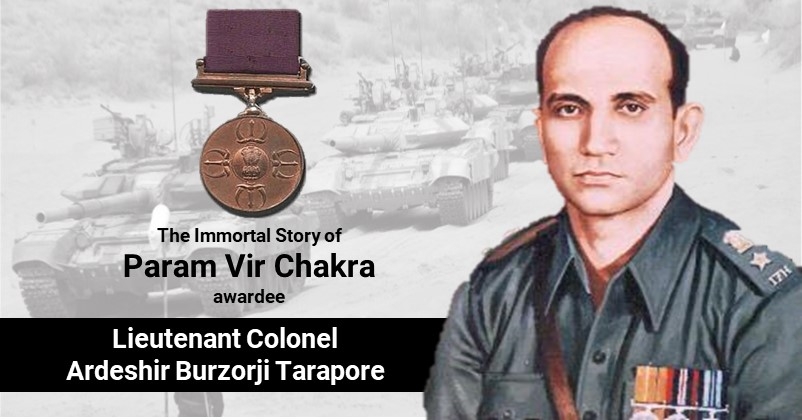| 14-Sep-2020 |

The capture of Chawinda was Part of the overall design of the overall design of 1 Corps in its operations in the Sialkot Sector. Poona Horse (17 Horse) commanded by Lieutenant Colonel A.B. Tarapore had a key role to play in this plan.
The area of Chawinda was held by about two regiments of Pakistan armour and infantry. 1 Armoured Brigade of which 17 Horse was a part launched its attack on 14 September 1965 but could secure only part of its objectives. Owing to heavy opposition encountered at Chawinda, the General Officer Commanding | Corps decided that unless a strong force was established behind Chawinda, and the position cut off, it would not be possible to capture the town.
Citation
Lieutenant Colonel A.B. Tarapore,
POONA HORSE (17 HORSE) (1c 5565)
On 11 September 1965, the Poona Horse Regiment under the command of Lieutenant Colonel Ardeshir Burzarji Tarapore was assigned the task of delivering the main armoured thrust for capturing Phillora in the Sialkot Sector in Pakistan. As a preliminary to making a surprise attack on Phillora from the rear, the regiment was thrusting between Phillora and Chawinda when it was suddenly counter-attacked by the enemy's heavy armour from Wazirali. Lieutenant Colonel A.B. Tarapore who was then at the head of his regiment, defied the enemy’s charge, held his ground and gallantly attacked Phillora with one of his squadrons supported by an infantry battalion. Though under continuous enemy tank and artillery fire, Lieutenant Colonel Tarapore remained unperturbed throughout this action and when wounded refused to be evacuated.
On 14 September 1965, though still wounded he again led his regiment to capture Wazirali. Such was his grit and determination that unmindful of his injury, he again gallantly led his regiment and captured Jassoran and Butur-Dograndi on 16 September. His own tank was hit several times, but despite the odds he maintained his pivots in both these places and thereby allowed the supporting infantry to attack Chawinda from the rear.
Inspired by his leadership, the regiment fiercely attacked the enemy’s heavy armour destroying approximately 60 enemy tanks at a cost of only 9 tank casualties, and when Lieutenant Colonel A.B. Tarapore was mortally wounded and the regiment continued to defy the enemy.
The valour displayed by Lieutenant Colonel A B Tarapore in this heroic action which lasted six days was in keeping with the highest traditions of the Indian Army
Gazette of India Notification
No. 112—Press/65
Valour To The Fore
Let us have faith that right makes might and in that faith, let us, to the end, dare to do our duty as we understand it, ~ Abraham Lincoln
The antecedents of Lieutenant Colonel A.B. Tarapore are very Indian and very military. His ancestor, Ratanjiba, eight generations earlier, was a military leader under Shivaji. In appreciation of his services, loyalty, and bravery, Shivaji had given him the ‘Mansab’ (charge) of one hundred villages. The premier village in this Mansab was called Tarapur and it is since then that the family name of Tarapur came into use.
Ardeshir’s grandfather migrated to the Deccan and joined the Customs Department of the erstwhile Hyderabad State. Ardeshir’s father also joined the same department. He was an erudite scholar of Persian and Urdu.
Ardeshir (Adi) was born in Mumbai (then, Bombay) on 18 August 1923. At the young age of six he demonstrated the courage he was to show in future years when he saved his sister from a charging cow. At the age of seven, he joined Sardar Dastur Boy’s School, Poona.
Although not an exceptional student academically: he distinguished himself in athletics, gymnastics, boxing, swimming, tennis and cricket and matriculated from the school in 1940 as the school captain.
Adi was selected to serve in the Indian Army, and was posted to the Poona Horse on probation for two years. He first joined ‘B’ Squadron and later on ‘A’ Squadron as its second-in-command. Adi took to ‘A’ Squadron as a fish takes to water, and soon established a close rapport with the proud tradition-bound Rajputs as he himself was a firm believer in tradition.
In the 1965 Indo-Pakistan war he fought at the head of his regiment, Poona Horse, in the Sialkot Sector and led it courageously and aggressively for the capture of Phillora against
vastly superior numbers of Pakistani armour. He was injured on 14 September 1965 in a fierce tank battle in which a large number of Pakistani tanks were destroyed. He however refused to be evacuated on account of his wounds and continued to lead his regiment offensively against the enemy till he was wounded once again on 16 September 1965 and succumbed to his wounds.
Conclusion of the Indo-Pakistan War
Although many have termed the result of the 1965 .var with Pakistan a stalemate it would be more appropriate to say that It was Pakistan who lost the war. Pakistan failed miserably in her aim of annexing Jammu and Kashmir although all factors were heavily loaded in her favour—politically, economically and militarily. On the contrary it resulted in the near total destruction of one of her armoured divisions.
In facing the Pakistani offensive, India decided that the best alternative open to her was the destruction of Pakistani offensive forces and in this she substantially succeeded. The timely occupation of the Asal Uttar position and the conduct of its brave defenders like Company Quartermaster Havildar Abdul Hamid of 4 Grenadiers and the brave outrageous leadership displayed by Lieutenant Colonel A.B. Tarapore of 17 Horse and others like them turned the tide of the war.
It is the leadership and courage of brave men such as these that sometimes change the course of history and the destiny of the nations.